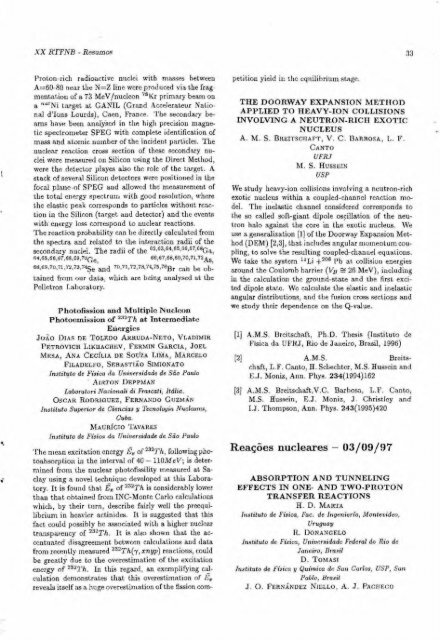REINA() DE TRABALHO SOBRE FiSICA NUCLEAR NO BRASIL
REINA() DE TRABALHO SOBRE FiSICA NUCLEAR NO BRASIL
REINA() DE TRABALHO SOBRE FiSICA NUCLEAR NO BRASIL
You also want an ePaper? Increase the reach of your titles
YUMPU automatically turns print PDFs into web optimized ePapers that Google loves.
XX RTFNB Resumos 33<br />
Proton-rich radioactive nuclei with masses between<br />
A=60-80 near the N=Z line were produced via the fragmentation<br />
of a 73 MeV/nucleon 78 1ir primary beam ou<br />
a "`"Ni target at GANIL (Grand Accelerateur National<br />
d'Ions Lourds), Caen, France. The secondary beams<br />
have been analysed in the high precision magnetic<br />
spectrometer SPEC with complete identification of<br />
mass and atomic number of the incident particles. The<br />
nuclear reaction cross section of these secondary nuclei<br />
were measured on Silicon using the Direct Method,<br />
were the detector playes also the role of the target. A<br />
stack of several Silicon detectors were positioned in the<br />
focal plane of SPEC and allowed the measurement of<br />
the total energy spectrum with good resolution, where<br />
the elastic peak corresponds to particles without reaction<br />
in the Silicon (target and detector) and the events<br />
with energy loss correspond to nuclear reactions.<br />
The reaction probability can be directly calculated from<br />
the spectra and related to the interaction radii of the<br />
secondary nuclei. The radii of the 62 ' 63 ' 64 ' 65 ' 66 ' 67' 68GR,<br />
R4,65,66,67,68,69,700, 66,67,68,69,70,71,72 ,<br />
68,69,70,71,72,73,745e and 70,71,72,7s,74,75,76Br canbe ob<br />
tained from our data which are being analysed at the<br />
Pelletron Laboratory.<br />
Photofission and Multiple Nucleon<br />
Photoemission of 232Th at Intermediate<br />
Energies<br />
Jo;(o DIAS <strong>DE</strong> TOLEDO ARRUDA-NETO, VLADIMIR<br />
PETROVICH LIKIIACHEV, FERMIN GARCIA, JOEL<br />
MESA, ANA CECILIA <strong>DE</strong> SOUZA LIMA, MARCELO<br />
FILALIELFO, SEBASTIAO SIMIONATO<br />
Institute de Fisica da Universidade de Silo Paulo<br />
A IIITON <strong>DE</strong>PPMAN<br />
Laboratori Nacional di Frascati, lidlia.<br />
OSCAR RODRIGUEZ, FERNANDO GUZMAN<br />
Institute Superior de Ciencias y Tecnologia Nucleares,<br />
Cuba.<br />
MAUttfcio TAVARES<br />
Institute de Fisica da Universidade de Silo Paulo<br />
The mean excitation energy a. of 232T/i, following photoabsorption<br />
in the interval of 40 110MeV; is determined<br />
from the nuclear photofissility measured at Seeley<br />
using a novel technique developed at this Laboratory.<br />
It is found that .E z of 234 Th is considerably lower<br />
than that obtained from INC-Monte Carlo calculations<br />
which, by their turn, describe fairly well the preequilibrium<br />
in heavier actinides. It is suggested that this<br />
fact could possibly he associated with a higher nuclear<br />
transparency of 2322h. It is also shown that the accentuated<br />
disagreement between calculations and data<br />
from recently measured "'Th(y, xnyp) reactions, could<br />
be greatly due to the overestimation of the excitation<br />
energy of 235Th. In this regard, an exemplifying calculation<br />
demonstrates that this overestimation of Ez<br />
reveals itself as a huge overestimation of the fission com-<br />
petition yield in the equilibrium stage.<br />
THE DOORWAY EXPANSION METHOD<br />
APPLIED TO HEAVY-ION COLLISIONS<br />
INVOLVING A NEUTRON-RICH EXOTIC<br />
NUCLEUS<br />
A_ M. S. BREITSCTIAFT, V. C. BARBOSA, L. F.<br />
CANTO<br />
UFRJ<br />
M. S. HUSSEIN<br />
USP<br />
We study heavy-ion collisions involving a neutron-rich<br />
exotic nucleus within a coupled-channel reaction model.<br />
The inelastic channel considered corresponds to<br />
the so called soft-giant dipole oscillation of the neutron<br />
halo against the core in the exotic nucleus. We<br />
use a generalization [1] of the Doorway Expansion Method<br />
(<strong>DE</strong>M) [2,3], that includes angular momentum coupling,<br />
to solve the resulting coupled-channel equations.<br />
We take the system "Li -1- 2" Pb at collision energies<br />
around the Coulomb harrier (V, St-' 26 MeV), including<br />
in the calculation the ground-state and the first excited<br />
dipole state. We calculate the elastic and inelastic<br />
angular distributions, and the fusion cross sections and<br />
we study their dependence on the Q-value.<br />
[1] A.M.S. Brcitschaft, Ph.D. Thesis (Institut° de<br />
Fisica da UFRJ, Rio de Janeiro, Brasil, 1996)<br />
[2]<br />
A.M.S.<br />
chaft, L.F. Canto, H. Schechter, M.S. Hussein B and<br />
E.J. Tvloniz, Ann. Phys. 234(1994)162<br />
[3] A.M.S. Breitschaft,V.C. Barbosa, L.F. Gantt) ;<br />
M.S. Hussein, E.J. Moniz, J. Christley and<br />
I.J. Thompson, Ann. Phys. 243(1995)420<br />
Reaciies nucleares — 03/09/97<br />
ABSORPTION AND TUNNELING<br />
EFFECTS IN ONE- AND TWO-PROTON<br />
TRANSFER REACTIONS<br />
H. D. MARTA<br />
Institute de Fisica, Foe. de Irigenieria, Montevideo,<br />
Uruguay<br />
R. DONANGELO<br />
lnstituto its Fisica, Universidade Federal do Rio de<br />
Janeiro, Brasil<br />
D. TOMAST<br />
Institute de Fisica y Quimica de Sun Carlos, USP, San<br />
Pablo, Brasil<br />
J. 0. FERNAN<strong>DE</strong>Z NIELLO, A. J. PACHECO
















